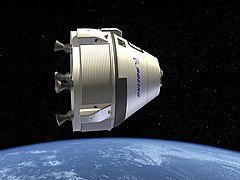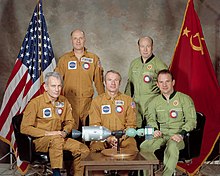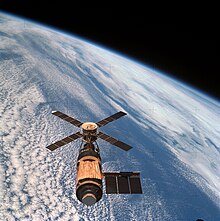Beyond Low Earth Orbit program (2010–present)
For missions beyond low Earth orbit (BLEO), NASA has been directed to develop the Space Launch System (SLS), a Saturn-V class rocket, and the two to six person, beyond low Earth orbit spacecraft, Orion. In February 2010, President Barack Obama's administration proposed eliminating public funds for the Constellation program and shifting greater responsibility of servicing the ISS to private companies.[90] During a speech at the Kennedy Space Center on April 15, 2010, Obama proposed a new heavy-lift vehicle (HLV) to replace the formerly planned Ares V.[91] In his speech, Obama called for a manned mission to an asteroid as soon as 2025, and a manned mission to Mars orbit by the mid-2030s.[91] TheNASA Authorization Act of 2010 was passed by Congress and signed law on October 11, 2010.[92] The act officially canceled the Constellation program.[92]
The Authorization Act required a newly designed HLV be chosen within 90 days of its passing; the launch vehicle was given the name "Space Launch System". The new law also required the construction of a beyond low earth orbit spacecraft.[93] The Orion spacecraft, which was being developed as part of the Constellation program, was chosen to fulfill this role.[94] The Space Launch System is planned to launch both Orion and other necessary hardware for missions beyond low Earth orbit.[95] The SLS is to be upgraded over time with more powerful versions. The initial capability of SLS is required to be able to lift 70 mt into LEO. It is then planned to be upgraded to 105 mt and then eventually to 130 mt.
https://en.wikipedia.org
See this video is explaining why the nasa
can´t go beyond low the earth orbit
https://www.youtube.com








